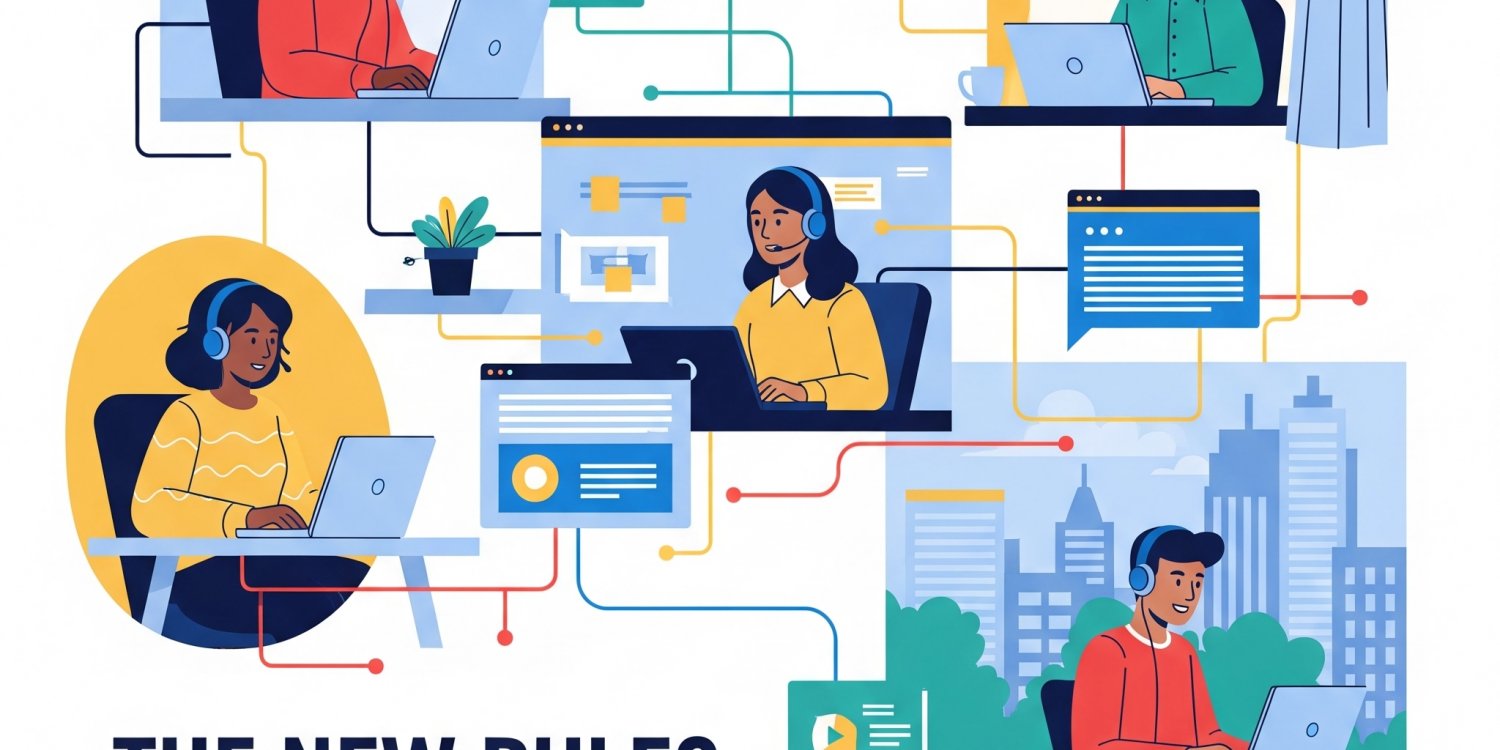The shift toward remote work and virtual operations has dramatically reshaped the way businesses structure their support teams. In this new landscape, the traditional office‑based call center is no longer the default. A company’s ability to deliver exceptional customer care now hinges on mastering the rules of distributed support. These principles cover everything from the services offered to role design, technology integration, team collaboration, and cross‑industry best practices.
At its core, remote support redefines what it means to provide assistance across time zones and cultures without sacrificing quality. The best support experiences now demand agents who are equipped not only with system access but also with emotional intelligence and a mindset oriented toward flexibility and adaptability. In this blog, we will explore how the guiding rules of remote support have changed and what organizations need to employ to succeed with services built for the new world. These ideas apply not only to traditional call centers but also to outsourced partners, help desk staff, freelancers, and internal customer care teams.
The Imperative for Remote‑Ready Support Services
Remote support is no longer a temporary fix; it is the new normal. Customers expect to be answered at any hour from any location. This expectation is especially true in industries such as e‑commerce, SaaS, healthcare, finance, education, and more. As more businesses rely on distributed teams, the ability to deliver consistent services virtually becomes a competitive advantage.
The first rule of remote support is to ensure that service offerings are truly remote capable. This means offering channels such as live chat, email, video calls, social media messaging, and phone in standardized formats. It also means structuring schedules to match global user time zones. Agents must be empowered to operate autonomously with full access to systems while still feeling connected to a cohesive support culture. New rules of remote support also stress the importance of providing agents with healthy routines to manage isolation and psychological wellbeing while maintaining high performance.
Establish Clear Expectations and Tools
The foundation of effective remote support is clear expectations. Agents must understand what services they are delivering and how success is measured. For example, first response time, resolution rate, customer satisfaction, and average handling time all remain important. However the remote world also calls for agent engagement metrics such as remote attendance, mental health check‑ins, virtual peer‑recognition, and knowledge sharing.
To succeed agents need tools that replicate office workflows from anywhere. Cloud‑based CRMs, remote desktop tools, shared knowledge bases, integrated communication platforms, and video‑enabled team rooms are essential. These tools must be chosen to allow full feature sets, screen sharing, history tracking, escalation workflows, and remote collaboration.
Training for remote teams must be ongoing. Agents should learn not only systems but also remote etiquette, asynchronous communication, digital empathy, and self‑management skills. This builds cohesion and ensures standards across the board even when employees are scattered.
Prioritize Empathy and Human Connection
One of the greatest challenges of remote support lies in maintaining the human touch. Customers interacting with a virtual agent can sense when responses are generic. In a remote environment, every interaction must foster connection. This is where empathy becomes the rule central of the support strategy.
Agents must be trained to read emotional cues even in text‐based channels. Apologizing when appropriate, validating feelings, and providing reassurance are all part of emotional intelligence that builds rapport. In voice or video environments, tone, pacing, and clarity are crucial. Over communication becomes standard so that customers never feel left dangling.
From an organizational standpoint, leadership must create opportunities for remote support teams to connect on a personal level and in community settings. This can include virtual team lunches, peer‑to‑peer recognition programs, and remote team scavenger hunts. When agents feel part of something bigger than their screen they are more motivated to deliver service with heart.
Align Support With Industry‑Based Expertise
The new rules embrace domain expertise. Not every customer query is the same, and industries like healthcare, finance, legal, travel, and education require highly specialized knowledge. Support must be able to speak the language of industry compliance, privacy regulations, billing structures, technical tiers, and unique workflows.
This means services must be segmented by vertical or by topic. Agents supporting sensitive industries need certifications and training. A generalist model no longer cuts it in a remote world. Instead there is need for Tier One general support, Tier Two specialists, and deep escalation for complex scenarios. Teams must be small enough to remain familiar to customers but large enough to ensure coverage.
In outsourcing partnerships or internal call center teams the same principle applies. When support is built around industry expertise, customers experience faster resolution, enhanced trust, and overall satisfaction. That expertise becomes a differentiator in crowded markets.
Leverage Scalable Technology Responsibly
Remote world support cannot survive without the right technologies. Automation, AI, chatbots, self‑service portals, sentiment analysis, workforce management, and analytics are part of the modern support stack. However these tools must be used carefully.
Automation should handle routine FAQs while routing complex issues to live agents quickly. AI‑assisted suggestions can aid agents by surfacing responses but should not replace human review. Sentiment analysis tools help flag unhappy customers before problems escalate. Analytics can monitor performance, identify peak periods, and help teams forecast staffing needs.
Scalability is key. Support services need to ramp up during product launches, marketing promotions, or seasonal demands. Remote‑first agents mean hiring across locations becomes easier. But scaling must also include maintaining culture, consistent training, and coherent workflows.
In short, technology should amplify human support, not replace it. The new rule is balance.
Create a Culture of Continuous Improvement
Remote support demands iteration and improvement. With agents spread out and communications virtual, organizations need proactive ways to identify weaknesses and seed opportunity. Static training won’t work. Instead service teams must operate within a culture of continuous improvement, guided by data and regular feedback sessions.
Weekly retrospectives, monthly performance reviews, recorded chat reviews, and customer surveys must all feed into training and process enhancements. Remote leaders must ensure every agent feels empowered to suggest improvements or new ideas. This grassroots knowledge sharing helps service evolve more rapidly than centralized mandates ever could.
Support content must be dynamic too. Knowledge bases, FAQs, canned responses, and escalation rules must remain updated to account for new product launches, policy changes, or seasonal campaigns.
Measure What Matters and Adapt Fast
Measurement drives strategy. In a remote call center, data from services must be captured in real time and reviewed across multiple dimensions. Beyond core metrics like resolution time or net promoter score, newer measures such as time to empathy, escalation rates, or agent wellbeing scores must be tracked.
These measures inform decisions on staffing, training needs, and platform investment. They also allow leadership to anticipate remote team stress during volume peaks or global holidays. Flexibility in shift planning and cross‑training agents across industries becomes possible only when metrics guide full visibility.
Foster Inclusive Hiring and Training
Remote support teams are increasingly global and culturally diverse. This diversity is a powerful asset, customers connect better with agents who understand their market or language nuance. The new rules mandate inclusive hiring to build diverse support teams.
Training must reflect this diversity with localization, cross‑cultural communication norms, and multilingual capability. Remote call centers must promote internal mobility so agents can specialize in different industries over time. That builds engagement and helps support teams gain domain depth while maintaining remote cohesion.
Unite Voice Video and Text Seamlessly
In the remote support environment entry channels are manifold. Some customers prefer phones, others prefer chat or social messaging. Others want self‑service portals or AI‑chatbots. The new rule is to offer seamless omnichannel support where conversations follow the customer, not the platform.
Agents must be able to shift from chat to voice to video without losing the thread. Context needs to move with the customer so they do not have to repeat information. A modern call center supports all of these handoffs smoothly.
Central to this is unified CRM technology. It must track conversation history, escalate based on urgency, and alert staffing systems accordingly. This results in a support experience that feels integrated rather than fragmented.
Build Trust Through Security and Privacy
Remote support teams operate on home networks, laptops, and decentralized systems. That raises significant security risks around customer data, especially in regulated industries like finance, healthcare, and education.
The new rules require strict security protocols across remote infrastructure. Support agents should connect via VPNs, use encrypted communication, store no data locally, and undergo regular compliance training. Regular audits, access controls, and logging become mandatory.
Customers need assurances their personal information is handled securely. Support teams must learn best practices, not just for customer experience but for data protection. Security becomes a pillar of trust.
Encourage Balance and Wellbeing
Remote support can be demanding, and agent burnout is real. The last rule acknowledges that sustainable service requires supporting the supporters. Remote teams need well‑being initiatives, peer‑to‑peer support circles, flexible scheduling, and break policies to stay healthy and engaged.
Services must include mental health resources, virtual wellness events, and supervisor check‑ins. Agents working in isolated environments need tools and encouragement to maintain work‑life boundaries.
Ultimately, when agents feel cared for, customers feel cared for too.
Putting It All Together
The blueprint for successful remote support is built on these interconnected rules. Together they shape a support ecosystem capable of delivering quality services across industries, respecting both customers and agents. Whether it is an internal support desk or an outsourced call center, these principles serve as a guidebook:
- Design services for remote flexibility.
- Equip teams with tools, structure, and autonomy.
- Build empathy into every interaction.
- Segment expertise by industry.
- Use technology to amplify human skills.
- Embrace continuous improvement.
- Measure wisely to adapt quickly.
- Cultivate diversity and inclusion.
- Secure customer data at every step.
- Champion agent wellbeing.
These ideas transcend traditional models and reflect what customers expect in the digital age: caring, trustworthy, efficient support delivered from wherever the agent works.
To Sum It Up
The remote world has rewritten the rules of customer care. Organizations that embrace these tenets will find they can deliver exceptional support without relying on centralized contact centers. With the right services, tools, leadership, and mindset, remote support becomes not just possible but advantageous.
As the world continues to shift, support teams built on this modern blueprint will be ready to serve any industry under any conditions. Customers will receive prompt, personalized, and caring assistance. Agents will thrive in environments that value both performance and people.
This is the future of support. And it starts now.

